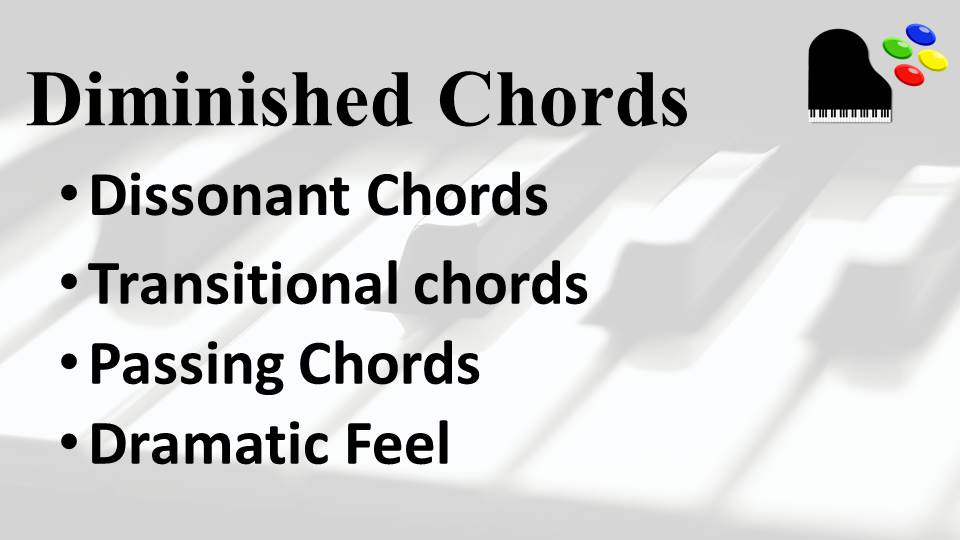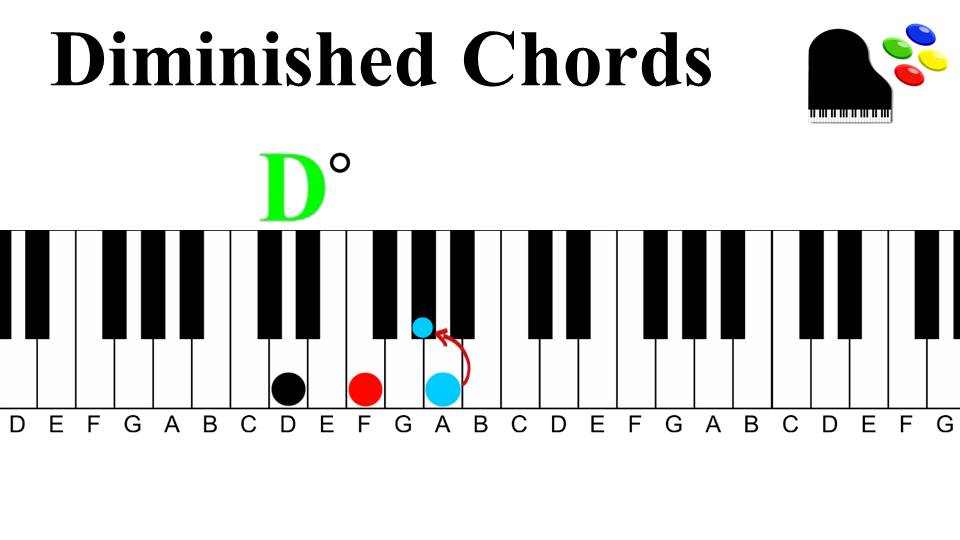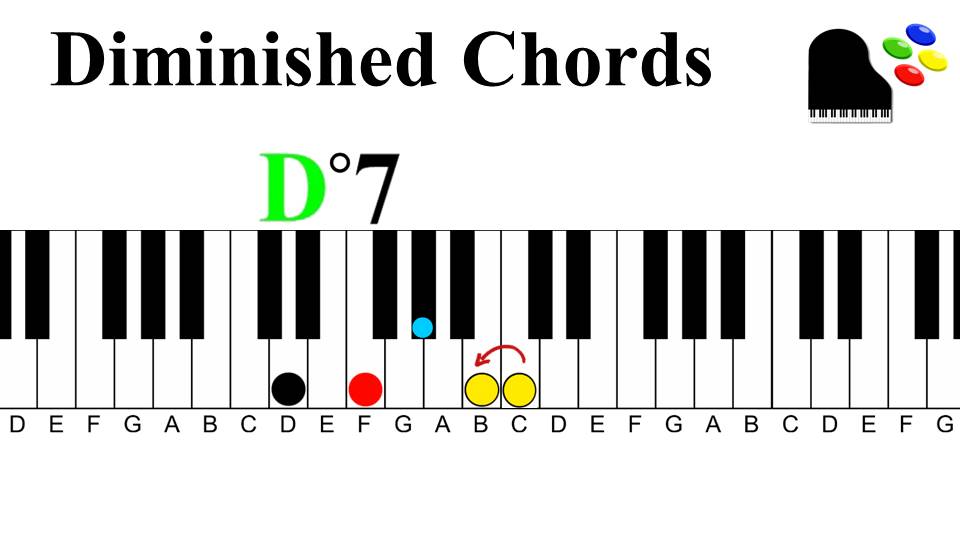 We're starting out in the key of E flat Major. Notice how the 7 different colors represent the 7 different notes in the key.
We're starting out in the key of E flat Major. Notice how the 7 different colors represent the 7 different notes in the key.
 We're using the 1-6-2-5 Chord Progression.
We're using the 1-6-2-5 Chord Progression.
 Our I chord is a simple E flat Major chord. The left hand is playing the root in octaves while the right hand is voicing the E flat Major chord with the root on top.
Our I chord is a simple E flat Major chord. The left hand is playing the root in octaves while the right hand is voicing the E flat Major chord with the root on top.
 Instead of proceeding right into the progression, we'll play a simple chord vamp also known as plagal cadence which is essentially a I chord to a IV chord. To give this plagal cadence some variety, we'll play the IV chord over the I chord. By definition this is known as a polychord which is defined as one chord over another.
Instead of proceeding right into the progression, we'll play a simple chord vamp also known as plagal cadence which is essentially a I chord to a IV chord. To give this plagal cadence some variety, we'll play the IV chord over the I chord. By definition this is known as a polychord which is defined as one chord over another.
 This plagal cadence will take us back to the I chord. Notice it's voiced the same as it was before. The plagal cadence can cycle a few times before moving on through our Gospel chord progression.
This plagal cadence will take us back to the I chord. Notice it's voiced the same as it was before. The plagal cadence can cycle a few times before moving on through our Gospel chord progression.
 One very notable characteristic of a gospel progression is to utilize passing chords to add interest and flavor to the music. I like to think of these as detours within the chord progression.
One very notable characteristic of a gospel progression is to utilize passing chords to add interest and flavor to the music. I like to think of these as detours within the chord progression.
 Diminished chords are common in all styles of music. For gospel music, they're almost essential because they're such a signature of the gospel sound. They're almost exclusively used as passing chords. These are transitional chords that are played between the main chords in the gospel chord progression.
Diminished chords are common in all styles of music. For gospel music, they're almost essential because they're such a signature of the gospel sound. They're almost exclusively used as passing chords. These are transitional chords that are played between the main chords in the gospel chord progression.
Unlike Major and minor chords, they have a dissonant sound that give them an unstable character. For this reason, they don't stand on their own, but when used in context they add a lot of flavor to what would ordinarily be a bland sounding chord progression.
 Among the simplest diminished chords are diminished triads. You can start the construction of a diminished triads by creating a minor chord from a Major chord by lowering the third (the middle note) down a half step.
Among the simplest diminished chords are diminished triads. You can start the construction of a diminished triads by creating a minor chord from a Major chord by lowering the third (the middle note) down a half step.
 By lowering the fifth (the top note) down a half step, you can create a diminished triad. The diminished triad shown on the card above is in root position but as with any chord it can be played in any inversion.
By lowering the fifth (the top note) down a half step, you can create a diminished triad. The diminished triad shown on the card above is in root position but as with any chord it can be played in any inversion.
 The dominant 7th tone (C in the D Major chord) can be lowered a half step and added to a diminished triad. This creates a fully diminished 7th chord. If you're familiar with intervals, you'll notice that they're just a stack of minor 3rds.
The dominant 7th tone (C in the D Major chord) can be lowered a half step and added to a diminished triad. This creates a fully diminished 7th chord. If you're familiar with intervals, you'll notice that they're just a stack of minor 3rds.
 We're going to proceed down to the vi chord by transitioning through a couple of passing chords. We're going to voice the D diminished 7th chord as you see it in the card above. Your left hand is playing the root in octaves while the remaining four tones in the right hand are playing the stack of minor 3rds as I mentioned earlier.
We're going to proceed down to the vi chord by transitioning through a couple of passing chords. We're going to voice the D diminished 7th chord as you see it in the card above. Your left hand is playing the root in octaves while the remaining four tones in the right hand are playing the stack of minor 3rds as I mentioned earlier.
 Just before the vi chord we'll play another diminished 7th chord based on the flat 7 tone of E flat which is D flat (D flat diminished 7th) The voicing structure is identical to the D diminished chord played just before it.
Just before the vi chord we'll play another diminished 7th chord based on the flat 7 tone of E flat which is D flat (D flat diminished 7th) The voicing structure is identical to the D diminished chord played just before it.
 Now we arrive at the vi chord in our Gospel progression. It's a simple C minor 7 chord. This gives us a break from the succession of the last two diminished 7th chords and resolves (0r rests) at the more stable minor 7th chord.
Now we arrive at the vi chord in our Gospel progression. It's a simple C minor 7 chord. This gives us a break from the succession of the last two diminished 7th chords and resolves (0r rests) at the more stable minor 7th chord.
 Now we move on to the II chord in our Gospel progression. A II chord is often played as a minor chord but as you can see in the preceding card, it's an altered chord. It's a dominant 7th chord with a sharp 9 (G sharp) and sharp 5 (C sharp). This is quite a dissonant sounding chord that's essentially being exploited as a passing chord. It works quite well to flavor up our Gospel chord progression.
Now we move on to the II chord in our Gospel progression. A II chord is often played as a minor chord but as you can see in the preceding card, it's an altered chord. It's a dominant 7th chord with a sharp 9 (G sharp) and sharp 5 (C sharp). This is quite a dissonant sounding chord that's essentially being exploited as a passing chord. It works quite well to flavor up our Gospel chord progression.
 Rather than going straight to the V chord, we'll use another diminished 7th chord to precede it. The A diminished 7th chord will be played with the root and diminished 7th in the left hand and that stack of minor 3rds in the right. Notice that the diminished 7th tone is also played in the right hand.
Rather than going straight to the V chord, we'll use another diminished 7th chord to precede it. The A diminished 7th chord will be played with the root and diminished 7th in the left hand and that stack of minor 3rds in the right. Notice that the diminished 7th tone is also played in the right hand.
 Now we arrive at the V chord in our Gospel progression. It would be common for the V chord to be a dominant 7th chord (B flat 7). But in this case we'll choose to play the IV over the V chord. This is also known as a polychord which I mentioned earlier. The left hand will essentially play a B flat power chord (no third) and the right hand will play a simple A flat Major triad. This IV over V chord has a very strong pull back to the I chord.
Now we arrive at the V chord in our Gospel progression. It would be common for the V chord to be a dominant 7th chord (B flat 7). But in this case we'll choose to play the IV over the V chord. This is also known as a polychord which I mentioned earlier. The left hand will essentially play a B flat power chord (no third) and the right hand will play a simple A flat Major triad. This IV over V chord has a very strong pull back to the I chord.
 Now we're back to our I chord in our 6-2-5-1 Gospel chord progression. Watch the video on diminished chords to see a demo of this progression in F Major also.
Now we're back to our I chord in our 6-2-5-1 Gospel chord progression. Watch the video on diminished chords to see a demo of this progression in F Major also.
In this Video & Cards article, we showcased Diminished 7 chords and how they're used in a Gospel Progression. However, you can interject them in any popular style of music when you want to add a Gospel flavor to your chord progressions. Let me also add that because fully diminished 7th chords are a stack of minor 3rds, there are only three of them. The short explanation of there only being three fully diminished chords is that they're just inversions of each other. But we'll leave that for another time.
Until next time, Go Play!
Greg Lee
Latest posts by Greg Lee (see all)
- What is a minor/Major 7 Chord? - October 26, 2023
- 7 Chord Substitutions that Professionals Use - October 19, 2023
- 5 Simple Chord Tricks to Sound Amazing - October 5, 2023



